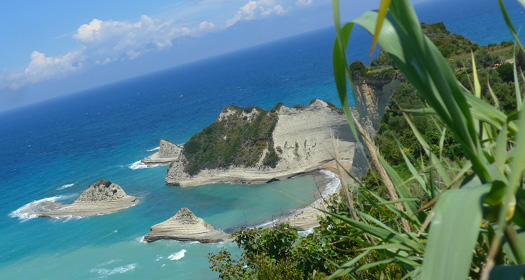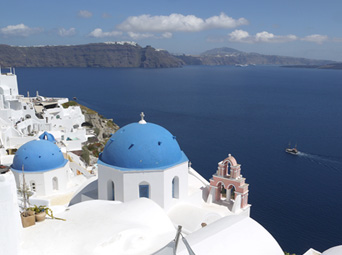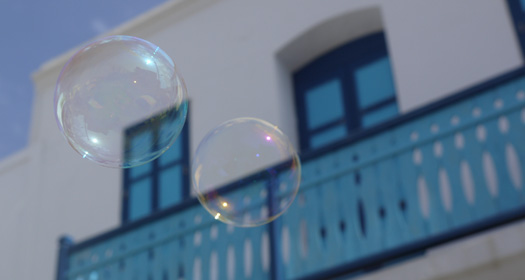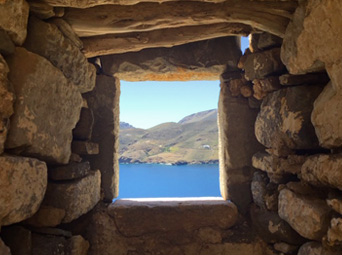

| May 22, 2019 | Georgios, Greece - Dream Time's last anchorage amongst the isles of the Aegean Sea. |
|

|
May 22, 2019 (Day 4,374)
Quick Fix: 39° 39.6 N / 19° 51.3 E
Corfu, Greece

Getting a Move On
The last time we had Force 8 winds - 45 knots, stretching our sails, a gale forced us out of a Norfolk Island anchorage in the South Pacific. It’s been an exciting month for Dream Time: after exploring 10 Greek isles in the Aegean Sea we are now heading northwest through the Ionian with Italy and Croatia on our minds. Last week, after a day trip into the capital city to pay our respects to Athena, we transited the Corinth Canal, a shortcut across southern Greece, before strong easterly winds had us charging west at 8 knots under just a scrap of headsail. We are now steaming north towards Corfu in silky seas with sails hanging in a 5 knot breeze, and if the weather gods allow, we will raise southern Italy next week, Croatia next month, and Spanish isles sometime in August. We plan to cross the Atlantic this year, from the Canary Islands back to the Caribbean in December, about 5,000 nautical miles. So we best get a move on. |
|

|
 |

|

| May 16, 2019 | Athens, Greece - Got a spare day waiting for the winds to shift to east, so we paid our respects to Athena and visited the Parthenon. |
|

| May 15, 2019 | Corinth Canal, Greece - A 174 Euro shortcut. At only 4 miles long the Corinth Canal is one of the most expensive canals, per mile, to transit in the world. |
|
|
| |


|
|
|
 |
Day 4,362 - Santorini, Greece
18:19hrs - May 10, 2019
Santorini |

Santorini is probably the most photographed island in all of Greece, and it’s easy to see why. The ancient and still active volcano rises dramatically from deep sapphire seas with impressive rock and ash sandwiched together in great bands of black, gray and red - each compressed layer evidence of past eruptions, with an epic explosion blowing away the west side of the island in 1440 BC, to the most recent burp in the mid 1900s. These contrasting layers climb the islands steep cliffs to meet fertile soil plateaus six hundred feet above sea level where, resting on green terraces, row upon row of the island’s famous grapes catch the sun, while on the ridge line and spilling partially down the cliffs, clusters of dazzling whitewashed houses reflect the light and have new arrivals believing they are snow capped mountains.
We detoured south to Santorini in favorable northerly winds only to find that the one and only marina on the island’s southern shore, a tiny boat basin nestled behind ancient rock moles, is now the base for a large fleet of day charter catamarans, and a quick call to the marina on VHF confirmed that there was absolutely no room for the likes of Dream Time. Our arrival coincided with the entire fleet departing for the evening sunset cruise, a convoy of over twenty 45-foot catamarans motoring at full steam into the active caldera. Dream Time fell in line but was quickly left behind.
With fading light and few options on where to spend the night, we anchored alone in the very center of the six mile long sunken crater in twenty feet of water surrounded by depths of over 1,000 feet, perched on the edge of a petrified lava plug (with a trip-line to retrieve our ground tackle if needed), and we had one of the best views in the house.
Santorini is certainly a beautiful island, but the combination of steep cliffs, deep rocky seabeds and shorelines exposed to wind and swell, make it less than ideal for mariners and a tad tricky to anchor if you wish to leave your boat unattended. Even a cruise ship met its demise here when in 2007 it struck the island and sank inside the crater and right on the shoreline in depths of 600 feet, where it still rests today.
To find Dream Time a safe berth for the day we reclaimed our anchor from the rocky bottom the next morning (trip line not required) and sailed away from the lava islands in the middle of the caldera three miles to the village of Oia (“ee-a”) on the northern rim, where we quickly made friends with Captain Cosmos, a local charter boat owner, who kindly offered us the use of his mooring for the day while he sailed tourists around one of the world’s largest volcanic craters.
It’s no wonder that Santorini is the most popular island in the Cyclades, and in addition to the endless stream of ferries and flights, three or more cruise ships visit Santorini each day, Med mooring inside the gigantic caldera before unloading thousands of visitors which, unfortunately, for the Santorini donkey, need to be hauled up the side of the volcanic rim along steep, zigzaggy cobbled paths. Some tourists opt to walk, others take a bus, a few ride the cable car, but still hundreds of tourists clamber onto the backs of these unfortunate creatures that seem doomed to a life of endless drudgery. But thankfully, for the donkeys at least, animal activists managed to pass a law just last year noting that due to the increasing size of some cruise ship passengers, it is now illegal to force these poor animals to carry tourists weighing more than 220 lbs. A small win for the donkey!
We chose to walk but discovered that a portion of the path less traveled in our corner of the crater, from sea level to Oia, had collapsed last month sending slabs of concrete and wall tumbling hundreds of feet down the cliff face below. Thankfully no donkeys, or people, were climbing the path at the time. Only a few feet of crumbling ledge bridged the broken section, but hugging the cliff we edged across the void without issue and jimmied open the temporary gate erected to prevent eager tourists from attempting the descent.
We discovered that the best part of Santorini, for us at least, was the view, so after touring the island in a tiny Fiat Uno and buying a few bottles of Santorini red, we enjoyed a two hour lunch perched on a balcony with an expansive view of the deep crater, cruise ships moored in the distance and Dream Time berthed just below. And it was a scene, complete with two church domes painted sky-blue and a pink bell tower nestled amongst a canopy of white roofs overlooking the caldera, that we later learned is the most famous in all of Santorini.
We returned to Dream Time just fifteen minutes before Captain Cosmos arrived to reclaim his mooring, and with a light westerly, sailed the three miles south back to the lava islands resting in the caldera where we hooked a mooring for the night in a small inlet within the great piles of shiny black boulders - the most recent to be belched from the crater. And remarkably, we discovered that the middle of this volcanic wasteland is home for a local fisherman, a man who lives alone with no power or running water in a tiny house built within the giant heaps of volcanic slag - and we would love to know how he claimed this land or got a permit to build.
His only company out here are some chickens, a pig, a few dozen scrappy goats and his dog, a giant German shepherd who eyed us with suspicion anchored so close to his territory and occasionally, for no apparent reason, let loose a volley of heavy barks in our direction. It was a most peaceful and surreal setting: Dream Time resting on the edge of a lava island where, just a few boat lengths away, lived an old fisherman sprinkling grain on the ground and whistling softly to attract his goats who, hopping and skipping down from the black rocks above, gathered around him to feed outside his little house, which rested in the center of an active volcano, surrounded entirely by the sea. |
|

| May 9, 2019 | Santorini, Greece - Looking south into the flooded, and still active, volcanic caldron of Santorini - where we anchored in the middle last night. |
|

| May 9, 2019 | Santorini, Greece - We asked the waiter for a table with a view. |
|

|

|
May 8, 2019 (Day 4,360)
Quick Fix: 36° 47.5 N / 25° 44.7 E
Amorgos, Greece

Floating Amongst The Cyclades
It’s been a busy week: After circumnavigating the tiny and picturesque volcanic island of Nisyros, where we clambered down into the active crater that still belches muddy bubbles and hisses sulphurous clouds, we sailed further west to Astypalaia, an island that seems mostly undisturbed by tourism, anchored in a quiet cove where friendly locals invited us ashore to share slabs of bluefin tuna cooked over a beach fire, washed down with some of our Thai beer and seasoned with local herb. A gale had us relocate 35 miles to a tiny fisherman’s cove on Amorgos where for 2 days Dream Time stretched her snubber in 45 knots and, remarkably, was covered in orange sand blown over from the Saharan Desert. Sailing distances between these Greek isles average just 30 miles, and with a flexible schedule of which island to visit next, sailing conditions have been favorable. Winds will shift to the north so we've decided to take a detour south - to the famous island of Santorini! |
|

|
 |

|
|
| |


|
|
|
 |
Day 4,355 - Astypalaia, Greece
20:30hrs - May 3, 2019
Castle With A View |

I think there must be more castles per square kilometer around the edges of this pretty blue Mediterranean Sea than anywhere else we’ve been. And while there are lots of magnificent castles in lots of places, a magnificent castle at the top of a hill, with a commanding view across a sparkly Mediterranean sea is hard to beat.
Today we're at the castle above the little town of Astypalaia. It’s really a fort built in the 8th century B.C. to give the island's inhabitants some defense against the Barbary pirates, and its strong stone walls protected the islanders for centuries. But today after earthquakes and erosion have each taken their share of this grand ageing fortress, what's left for us now is a warm stone shell full of flowers. And windows that frame the same beautiful views they did centuries ago.
We have seen a number of castles in Greece now, but my absolute favorite has to be Rhodes. If you haven't seen it yet please try and go. It defies adequate description so you really do need to walk around in it, feel it, get lost in the maze of tiny streets and marvel at the genius of its defenses.
In 1522 four hundred ships under the command of Sultan Suleiman the Magnificent delivered 100,000 men to take Rhodes by force. Against this huge army and against all the odds just 7,000 Knights of Saint John under Grand Master Philippe Villiers de L'Isle-Adam managed to hold them off for six months, partly due to the knights advanced strategies, tactics and their legendary battle readiness, but also because they had a really great fortress. And it’s mostly still there.
I think we'll be visiting lots more castles. I think I'm going to love them all. |
|
|

 |
|

